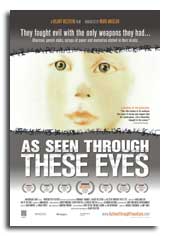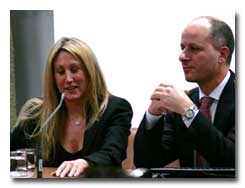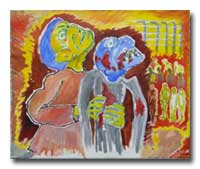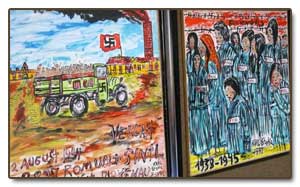27 January 2010
 "As Seen Through these Eyes" - a documentary film about artists who survived the Holocaust and their legacy by Hilary Helstein - was the main feature of this year's commemorations in Vienna. The documentary shows how these survivors produced an account that history could not - a journal of the Holocaust as seen through the eyes of the artists. These artists rebelled against the Nazis and risked their lives by doing what they were forbidden to do: create. Narrated by Pulitzer Prize-nominated poet Maya Angelou and produced in association with the Sundance Channel, this 70-minute documentary aims to combat prejudice, bigotry and intolerance. The words and the images of the surviving artists are profoundly moving, communicating horror and hope artistically. For them, art was and still is a means of survival, either directly by saving their lives during the Holocaust or by helping them to endure and move forward from the unbearable past.
"As Seen Through these Eyes" - a documentary film about artists who survived the Holocaust and their legacy by Hilary Helstein - was the main feature of this year's commemorations in Vienna. The documentary shows how these survivors produced an account that history could not - a journal of the Holocaust as seen through the eyes of the artists. These artists rebelled against the Nazis and risked their lives by doing what they were forbidden to do: create. Narrated by Pulitzer Prize-nominated poet Maya Angelou and produced in association with the Sundance Channel, this 70-minute documentary aims to combat prejudice, bigotry and intolerance. The words and the images of the surviving artists are profoundly moving, communicating horror and hope artistically. For them, art was and still is a means of survival, either directly by saving their lives during the Holocaust or by helping them to endure and move forward from the unbearable past.
The General Assembly designated 27 January as the annual International Day of Commemoration in memory of the victims of the Holocaust conducted during the Second World War by the Nazi regime in 2005. This year's main focus is on the "Legacy of Survival". Those who survived the horrors of the ghettos and Nazi death camps carry with them a message of the triumph of the human spirit and that message will continue to play a vital role in keeping the lessons of the Holocaust alive for future generations. When there are no survivors left alive, the legacy of their survival must live on - for instance in their stories and in their art.
 In his opening remarks, UNIS Director Maher Nasser said : "Our task, not only today, but every day is to ensure that the dangers of hatred, bigotry, racism and prejudice that led to the Holocaust are confronted and exposed to avoid a repeat of the horrors of the 20th Century.... The task remains as large today as it was anytime in the past 65 years since the Holocaust ended. In the latter part of the 20th Century we still saw atrocities, ethnic cleansing and mass killings in many parts of the world, including Europe where the lessons of the Holocaust ought to have been remembered."
In his opening remarks, UNIS Director Maher Nasser said : "Our task, not only today, but every day is to ensure that the dangers of hatred, bigotry, racism and prejudice that led to the Holocaust are confronted and exposed to avoid a repeat of the horrors of the 20th Century.... The task remains as large today as it was anytime in the past 65 years since the Holocaust ended. In the latter part of the 20th Century we still saw atrocities, ethnic cleansing and mass killings in many parts of the world, including Europe where the lessons of the Holocaust ought to have been remembered."
 In addition to the film, various works of art were on display, including original paintings by Karl Stojka who appears in the film and whose family was present at the screening. The work of Holocaust survivor Adolf Frankl which had been one of the inspirations behind making the film in the first place was on show, courtesy of Mr Frankl's son Thomas who runs the "Artforum Judenplatz" art gallery in Vienna. The hundred or so members of the audience, which included members of the Vienna diplomatic community, NGOs, schools and universities, as well as UN staff members, also had the opportunity to view reproductions of sketches by the late Simon Wiesenthal who appears in the film, as well as the photo exhibition "Vienna's Conscience" which was unveiled exactly one year ago.
In addition to the film, various works of art were on display, including original paintings by Karl Stojka who appears in the film and whose family was present at the screening. The work of Holocaust survivor Adolf Frankl which had been one of the inspirations behind making the film in the first place was on show, courtesy of Mr Frankl's son Thomas who runs the "Artforum Judenplatz" art gallery in Vienna. The hundred or so members of the audience, which included members of the Vienna diplomatic community, NGOs, schools and universities, as well as UN staff members, also had the opportunity to view reproductions of sketches by the late Simon Wiesenthal who appears in the film, as well as the photo exhibition "Vienna's Conscience" which was unveiled exactly one year ago.
In the conversation with writer and director Hilary Helstein which followed the screening, Ms Helstein explained how she had spent many years as a child and young woman struggling with the question of the Holocaust. She said she wanted to try to come to grips with this phenomenon and the horror of it all. Although in making the film she had gained an insight into the capacity of human beings for both atrocity and for beauty and resilience -- an insight that comes out in great detail in the film - she said that neverthelss she continues to struggle with the Holocaust as a subject and will probably do so for the rest of her life.
